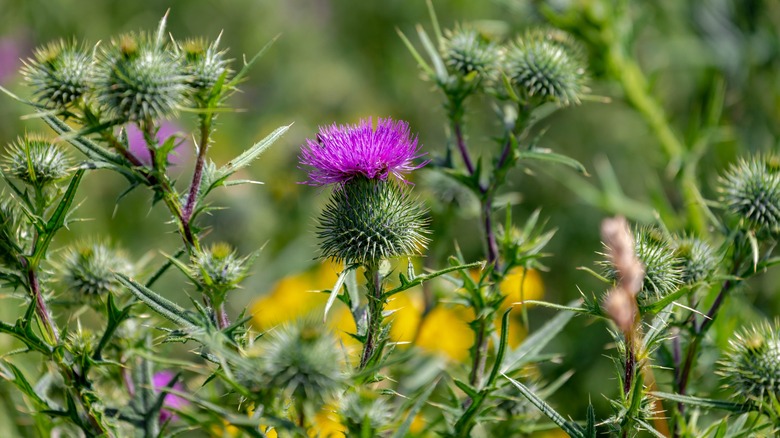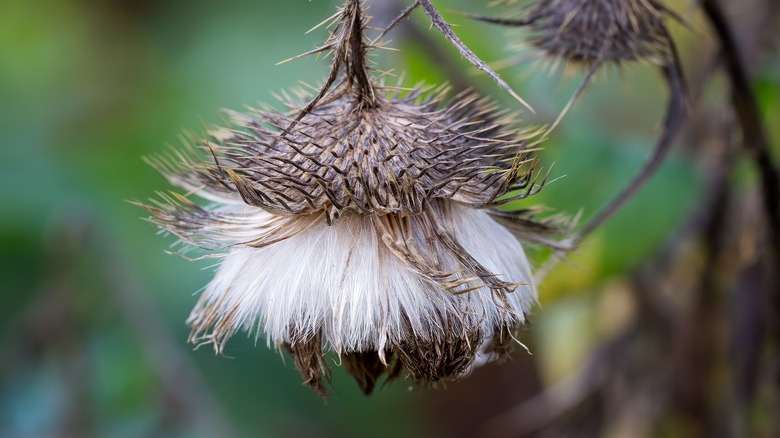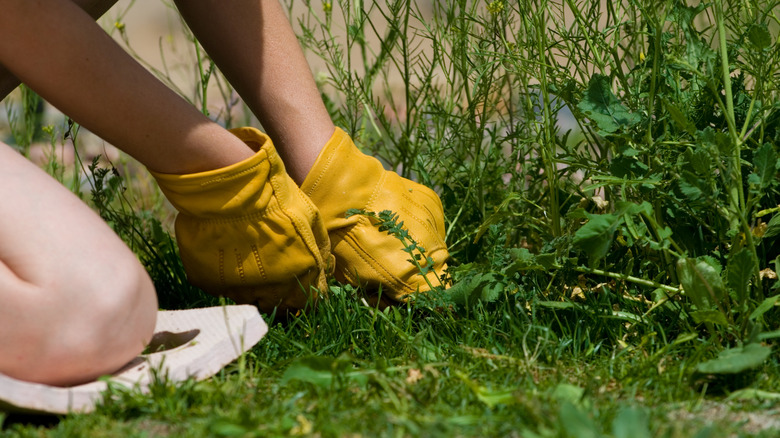How To Remove Prickly Bull Thistle Weed From Your Yard So It Doesn't Take Over
Despite the fact that hummingbirds will keep coming back for bull thistles, they're not really plants you want in your yard. They produce tons of seeds that germinate easily and will quickly take over your garden beds and lawn with prickly rosettes. If left to their own devices, they will eventually grow into tall, chaotic-looking spiny plants. The go-to method of dealing with bull thistles is yanking the rosettes or mature plants from the ground with gloved hands or cutting them off at the base of the stalk before they can flower. Other control options include mowing, letting animals or insects eat them, and, as a last resort, herbicides.
Bull thistle (Cirsium vulgare), also sometimes called spear thistle, Fuller's thistle, and lance-leafed thistle, is a biennial weed found in almost every state and territory in the USA, including Alaska and Hawaii. Originally native to West Asia, parts of Europe, and North Africa, the plant was accidentally introduced to North America by seed and grain imports and spread easily through contaminated hay.
Bull thistle starts out life as a prickly ground-hugging rosette that, in the summer, puts out tall, equally spiny stalks topped with purple flowers. Later, fluffy white seed heads form. You've probably spotted this thistle in well-used pastures, roadside ditches and banks, fence rows, and abandoned construction sites. And, for unlucky home gardeners, in garden beds or lawns. Unlike similar thistles like Canadian thistle, bull thistle doesn't have rhizomes (spreading roots); it spreads solely by seed. However, it's still considered moderately invasive.
Why bull thistle is a problem for gardeners
A mature plant can produce 4,000 to 5,000 seeds with a 90% germination rate every season. The seeds have parachutes and burrs, and spread by wind or hitching a ride on anything that brushes up against them. Bull thistle is extremely hardy, thriving in acidic and alkaline soils, heavy clay, and even gravel. It grows and spreads quickly, outcompeting native plants for water, food, and space. Plus, most grazing animals aren't a fan of eating it due to the spines, at least initially (more on this later), so it's often left untouched and growing happily in pastures.
Before you remove bull thistle, it's vital to make sure you're identifying it correctly. Native thistles are integral to the local ecosystem; some, like the Sacramento Mountain thistle (Cirsium vinaceum), for example, are threatened species. You don't want to remove them by accident. Identifying traits of bull thistle Cirsium vulgare include lobed leaves that are furry underneath and spiny on top but don't have the marbled patterns seen in other thistles. The leaves also have unique "wings" that extend down the stem and up to the flowerheads. The flowerheads resemble messy cobwebs and the purple flowers are less spiny than other thistle counterparts. What's helpful for your lawn or garden beds is that bull thistle seeds don't last long in the soil. Less useful is that disturbing the soil — for example, tilling or planting new plants — around the time seeds are being deposited encourages sprouting.
Try out these methods to get rid of bull thistle for good
The least harmful way to kill these weeds in your lawn and garden is to pull the bull thistle out with the taproot or cut the plant at the base before it flowers. As bull thistles are covered in spines, gloves are a must when weeding your garden! It could take one to four years to treat an infestation this way. It replicates by seed, so try to stop seed production by mowing at least twice a season — after planting flowers and again one month later. You can also manually cut off seed heads and throw them in the trash. Consider timing removal with your neighbors, and always clean seeds off garden tools.
Some broadleaf selective and non-selective herbicides, like Roundup, work on bull thistle, but it's important to be aware of health and environmental safety concerns associated with glyphosate. Other active ingredients found in effective herbicides include clopyralid, aminopyralid, chlorsulfuron, aminocyclopyrachlor, dicamba, and 2,4-D, but they must all be used with care. Always follow the instructions on the label and take recommended protective precautions seriously.
Some states have introduced bull thistle predators — like Urophora stylata, a seed-head-eating species of fruit fly, and the weevil species Trichosirocalus horridus — as a biological control. In other places, like Oklahoma, insects already eat bull and native species of thistles, reducing the spread. Horses, cows, sheep, and goats sometimes munch on bull thistle rosettes, though you might have to train them to do so. Of course, these methods are likely unsuitable for home gardens.


